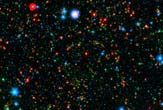Some Ancient Galaxies Had Wild Youth

Ancient galaxies may be cosmic senior citizens today, but some have a wild streak in their past, one packed with frenetic star birth, astronomers say.
Researchers using NASA's Spitzer Space Telescope have found that a significant set of galaxies in an ancient, distant cluster were actively forming stars about 10 billion years ago, which is how long it's taken for their light to reach Earth. [Photo of the galaxy cluster.]
The star birthrate is also oddly higher in the cluster's center than at its edges - the opposite of what has been observed in our local part of the universe, where galactic clusters are full of massive elliptical galaxies packed with only old stars.
Missing link of galaxies?
The recent discovery, made by an international team of researchers led by Kim-Vy Tran of Texas A&M University, may ultimately reveal more about how such massive galaxies form.
Astronomers have long suspected that star formation likely peaked long, long ago, when the universe was just a few billion years old. But the new findings may help pinpoint the epoch when galaxy clusters were making the last of their stars. Armed with this information, astronomers could focus on understanding why massive assemblies of galaxies transition from very active to passive.
"Our study shows that by looking farther into the distant universe, we have revealed the missing link between the active galaxies and the quiescent behemoths that live in the local universe," Tran said in a statement.
Sign up for the Live Science daily newsletter now
Get the world’s most fascinating discoveries delivered straight to your inbox.
Wild youths for old galaxies
Tran and her team spent four months analyzing images taken by Spitzer of a distant galaxy cluster known as CLG J02182-05102 about 10 billion light-years from Earth. The team determined that the galaxy cluster produces hundreds to thousands of new stars every year.
That's a far higher birth rate than what is seen in galaxies relatively nearby.
Exactly why the star-making power increases as galaxies become more crowded remains a mystery.
Tran suspects the densely populated surroundings could lead to galaxies triggering activity in one another, or that all galaxies were extremely active when the universe was young.
The fact that Tran's team was able to see these active galaxies so far back in time is only the preface to what they expect eventually to learn about these clusters. Tran will continue to lead an international collaboration to examine these clusters more thoroughly.
"We will analyze new observations scheduled to be taken with the Hubble Space Telescope and Herschel Space Telescope to study these galaxies more carefully to understand why they are so active," Tran said. "We will also start looking at several more distant galaxy clusters to see if we find similar behavior."
The research was detailed in the Aug. 20 issue of The Astrophysical Journal Letters.













